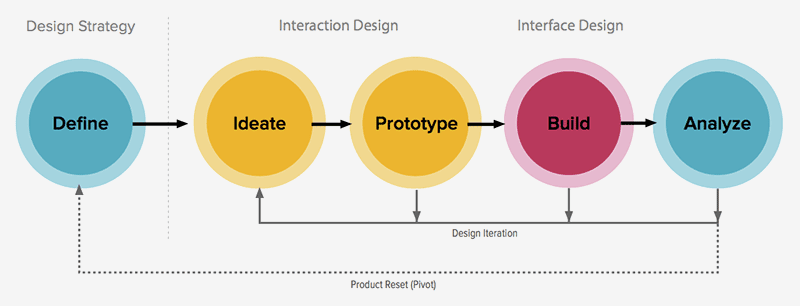From Sketch to Screen: The Design Process Explained
Every design starts with an idea—whether it’s to support a cause, improve someone’s life, or simply for fun. Regardless of the purpose, every idea follows a process from beginning to end. While this process may seem daunting at first, having an idea is the first and hardest step.
Once you have your idea, the next step is to use the design thinking method to determine your approach. “Design thinking is a non-linear, iterative process that can have anywhere from three to seven phases.” Non-linear thinking allows for flexibility, meaning one step doesn’t always directly lead to the next. This means you can apply design thinking whether you are reinventing a product or starting fresh. The five design stages that I’ll be discussing today are empathize, define, ideate, prototype, and test. By following these steps, you can refine your thinking and create a product you never imagined possible.
Empathize
The first stage of design thinking is empathizing, which focuses on understanding users by “identifying and empathizing with your target user and their needs.” To truly connect with your audience, designers conduct UX research, user interviews, and market analysis. Empathy allows for a deeper, more human-centered understanding of the problem at hand. It also provides insight into the user’s experience and motivations. The goal in this stage is to develop a thorough understanding of your users—their needs, potential challenges, and how your product can solve their problems.
Define
In the define stage, you compile and analyze all the information gathered during the empathize phase. After completing UX research, user interviews, and market research, you can now start identifying problems, setting goals, and establishing boundaries. To aid this process, you can create user flow maps, personas, and brainstorming sessions.
A user flow is the path a user takes while interacting with your product, helping visualize their experience step by step. Personas are fictional characters created based on analyzed data to better understand your users’ needs, experiences, and goals. This stage helps generate valuable ideas for features or functions that will address the problems uncovered in the empathize phase.
Ideate
“The third step of the design process is what most people envision when they think of a designer’s creative process.” This quote resonates because, for many, this stage represents what designers do—put ideas on paper and see what works. Personally, I still struggle to explain to my parents exactly what I do!
In reality, this is just the beginning of brainstorming and conceptualizing. This phase allows designers to challenge assumptions, experiment with new ideas, and determine what works best. After brainstorming, it’s time to create wireframes and mockups.
A wireframe is a basic sketch of your product’s layout, where icons and elements are represented as simple shapes and placeholders. A mockup is a more polished, high-fidelity version of the wireframe, incorporating real icons, colors, and content that will be used in the final product.
Prototype
The prototype stage is where the design begins to feel tangible. The design team creates a scaled-down, cost-effective version of the product to test its functionality. This prototype is shared with team members, other departments, or small testing groups to evaluate whether it effectively addresses the problem defined earlier.
It’s important to remember that not every idea will be implemented in the final product. However, discarded ideas shouldn’t be thrown away entirely—they may prove useful for future updates or solving different challenges. By the end of this stage, you’ll have a clearer understanding of potential problems and limitations.
Test
Testing is the final stage of design thinking, but it’s not a one-time step. Designers continuously return to testing because successful designs evolve through “a continuous cycle of updates and improvements to the design based on feedback from users and customers.”
After testing, the feedback received may lead you back to the ideate stage or even to redefine the problem entirely. This iterative process ensures that the final product is as effective and user-friendly as possible.
Conclusion
Mastering the design process takes time, but by embracing these five stages, you’ll create more user-focused and effective products. Whether you're refining an existing idea or starting from scratch, remember that iteration and feedback are key to great design. Keep testing, keep improving, and you’ll transform your ideas from simple sketches to impactful final products.
About the Author
Gabriel Romero is an interactive designer, photographer, and creative strategist passionate about storytelling through visuals and user experiences. With a background in graphic design and a knack for bringing ideas to life, he specializes in crafting engaging digital experiences and compelling brand narratives. When he's not designing or capturing moments through his lens, he's exploring new creative projects and refining his portfolio.


